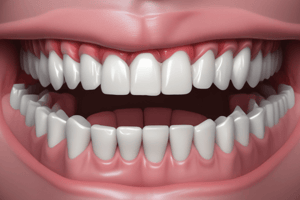Podcast
Questions and Answers
How many tooth numbering systems are mentioned in the content?
How many tooth numbering systems are mentioned in the content?
- 2
- 3 (correct)
- 5
- 4
What is the purpose of using tooth numbering systems?
What is the purpose of using tooth numbering systems?
Documenting patient treatment with accurate dental records.
The Palmer tooth notation system divides the upper and lower arch into __ quadrants.
The Palmer tooth notation system divides the upper and lower arch into __ quadrants.
4
Which tooth part is covered with cementum?
Which tooth part is covered with cementum?
What are the four tissues of the tooth?
What are the four tissues of the tooth?
Which is the hardest tissue in the body?
Which is the hardest tissue in the body?
The junction between enamel and dentin is known as DEJ.
The junction between enamel and dentin is known as DEJ.
The pulp chamber is located in the ______ portion of the tooth.
The pulp chamber is located in the ______ portion of the tooth.
Match the following tooth surfaces with their descriptions:
Match the following tooth surfaces with their descriptions:
Flashcards are hidden until you start studying
Study Notes
Tooth Numbering Systems
- There are three tooth numbering systems: Palmer, Universal, and International
- These systems are used to document patient treatment and record dental information accurately
- Each system has its own unique notation and method of identifying teeth
Palmer Tooth Notation System
- Most frequently used among orthodontists and practitioners in the United Kingdom
- Divides the upper and lower arch into four quadrants
- Uses simple brackets to represent the four quadrants of dentition
- In deciduous teeth, uppercase alphabetic letters represent the primary teeth in each quadrant
- In permanent teeth, numbers 1-8 are used in each quadrant, starting from the midline
Universal Numbering System
- Adopted by the American Dental Association in 1975
- Uses numbers 1-32 to identify the 32 teeth in the permanent dentition
- Maxillary teeth are numbered from 1-16, starting from the maxillary right third molar
- Mandibular teeth are numbered from 17-32, starting from the mandibular left third molar
- In primary dentition, uppercase letters A-T are used to identify the 20 teeth
International Numbering System (Federation Dentaire Internationale)
- Uses two digits to identify teeth, with the first digit indicating the dentition, arch, and side, and the second digit indicating the tooth position
- For permanent dentition, the first digit is 1-4, and the second digit is 1-8, starting from the midline
- For deciduous dentition, the first digit is 5-8, and the second digit is 1-5, starting from the midline
Tooth Structure
- Each tooth has a crown and root portion
- The crown is covered with enamel, and the root is covered with cementum
- The crown and root join at the cementoenamel junction (CEJ)
- The main bulk of the tooth is composed of dentin
Tooth Surfaces
-
The facial surface of the tooth is towards the face or lip
-
The lingual surface of the tooth is towards the tongue or palate
-
The occlusal surface is the surface of premolars and molars that come in contact with opposing jaw during closure
-
The proximal surfaces are the sides of the tooth next to an adjacent tooth, with mesial surfaces facing towards the midline and distal surfaces facing away from the midline### Line Angles and Point Angles
-
Line angle is formed by the junction of two surfaces and is named after both surfaces.
-
Point angle is formed by the junction of three surfaces and is named after these three surfaces.
Line Angles of Anterior and Posterior Teeth
- Anterior teeth have 6 line angles:
- Mesio-occlusal line angle
- Mesio-buccal line angle
- Mesio-lingual line angle
- Disto-occlusal line angle
- Disto-buccal line angle
- Disto-lingual line angle
- Posterior teeth have 8 line angles:
- Mesio-occlusal line angle
- Mesio-buccal line angle
- Mesio-lingual line angle
- Disto-occlusal line angle
- Disto-buccal line angle
- Disto-lingual line angle
- Bucco-occlusal line angle
- Linguo-occlusal line angle
Point Angles
- Anterior teeth have 4 point angles:
- Distolinguo incisal point angle
- Distolabio incisal point angle
- Mesiolinguo incisal point angle
- Mesiolabio incisal point angle
- Posterior teeth have 4 point angles:
- Distolinguo occlusal point angle
- Distobucco occlusal point angle
- Mesiolinguo occlusal point angle
- Mesiobucco occlusal point angle
Division into Thirds
- The crown and roots can be divided into thirds for descriptive purposes.
- The crown is divided into:
- Occlusal or incisal third
- Middle third
- Cervical third
- The root is divided into:
- Cervical third
- Middle third
- Apical third
- The crown can be divided in three directions:
- Inciso- or occlusocervically
- Mesiodistally (into mesial third, middle third, and distal third)
- Labio- or buccolingually (into labial or buccal third, middle third, and lingual third)
Studying That Suits You
Use AI to generate personalized quizzes and flashcards to suit your learning preferences.




